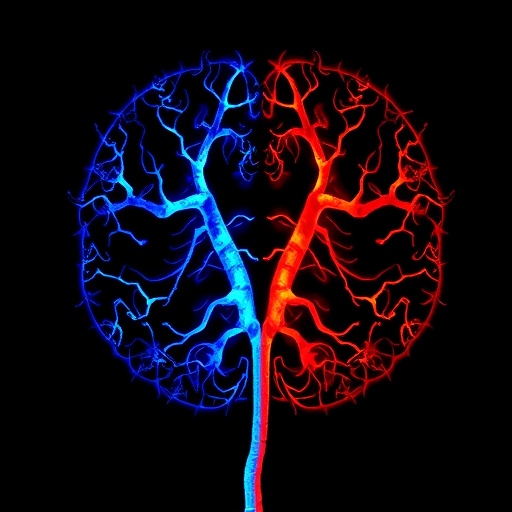
In recent years, the intricate workings of the glymphatic system have emerged as a transformative paradigm in understanding neurodegenerative diseases, particularly Parkinson’s disease (PD). A groundbreaking new study published in npj Parkinson’s Disease offers compelling insights into how asymmetries within this cerebral clearance system might be intricately linked to the lateralization of symptom onset in PD patients. By delving deep into diffusion-tensor magnetic resonance imaging (DT-MRI) techniques, researchers have mapped the subtle nuances of glymphatic function, revealing the potential underpinnings of one of the most enigmatic aspects of Parkinson’s pathology.
Parkinson’s disease has long been characterized by its hallmark motor symptoms, including unilateral tremor, rigidity, and bradykinesia, which frequently begin on one side of the body before progressing to the other. The biological mechanisms dictating this asymmetrical onset, however, have remained elusive despite decades of research. This latest investigation sheds light on the possibility that the glymphatic system—a network responsible for clearing metabolic waste and proteins from the brain—may not operate with symmetrical efficiency across the cerebral hemispheres, creating vulnerabilities that manifest as side-specific neurodegeneration.
The glymphatic system, aptly described as the brain’s waste disposal pathway, utilizes cerebrospinal fluid (CSF) to flush out toxic proteins such as alpha-synuclein and beta-amyloid, both of which disproportionately accumulate in PD and other neurodegenerative diseases. Using highly sensitive DT-MRI imaging, researchers were able to detect minute differences in glymphatic transport efficiency between the left and right sides of the brain. These differences correlated strongly with the side of motor symptom onset, unveiling a potential causal pathway between impaired glymphatic clearance and the spatial origin of Parkinsonian symptoms.
.adsslot_H3RMPkQ9F5{width:728px !important;height:90px !important;}
@media(max-width:1199px){ .adsslot_H3RMPkQ9F5{width:468px !important;height:60px !important;}
}
@media(max-width:767px){ .adsslot_H3RMPkQ9F5{width:320px !important;height:50px !important;}
}
ADVERTISEMENT
Importantly, diffusion-tensor imaging allows the visualization of water molecule movement along white matter tracts and fluid pathways. This technology, traditionally employed to assess neural integrity, has been innovatively applied here to track the flow of CSF within perivascular spaces—an integral component of the glymphatic system. The study’s application of sophisticated imaging protocols underscores the potential to non-invasively identify and quantify the degree of glymphatic asymmetry in vivo, a major technical advance in neuroimaging.
Beyond the immediate clinical implications, the study’s findings raise profound questions about the pathophysiological cascade in Parkinson’s disease. Could an inherent or acquired dysfunction in glymphatic clearance potentiate the initial seed of pathological protein aggregation on one side of the brain? This concept aligns with emerging hypotheses proposing that impaired waste clearance precedes neuronal death, offering a temporal window during which therapeutic interventions could mitigate disease progression before irreversible damage occurs.
Neuroanatomically, the glymphatic system is known to be more active during sleep, facilitating the removal of deleterious substances produced during wakeful neuronal activity. This raises intriguing intersections with clinical observations linking sleep disturbances and prodromal Parkinson’s symptoms. The current study suggests that asymmetries in glymphatic function might also parallel heterogeneity in sleep architecture or neurovascular dynamics between cerebral hemispheres, offering a multifactorial explanation for lateralized disease onset.
The implications for diagnostics are vast, as identifying glymphatic asymmetry through DT-MRI could serve as a biomarker to prognosticate Parkinson’s progression or to stratify patient populations in clinical trials. Early recognition of glymphatic impairment may pave the way for targeted therapies aimed at enhancing clearance mechanisms, potentially shifting the therapeutic landscape from symptomatic management towards disease modification.
This research also intricately ties into the neurovascular unit’s health, given the perivascular spaces’ critical role in glymphatic fluid transport. The study hints at the possibility that vascular factors and blood-brain barrier integrity asymmetries might underlie glymphatic inefficiencies. Future studies investigating endothelial cell dysfunction, microvascular inflammation, and their relationship with PD could uncover new pathological pathways for intervention.
Furthermore, this investigation broadens our conceptual framework beyond Parkinson’s, as glymphatic dysfunction has been implicated in a spectrum of neurological disorders including Alzheimer’s disease, multiple sclerosis, and traumatic brain injury. The technique of utilizing DT-MRI to map fluid dynamics in vivo introduces a universal platform to understand how impaired clearance contributes to diverse neurodegenerative states and how lateralization phenomena manifest therein.
Technically, the study represents a tour de force in neuroimaging, capitalizing on the resolution and sensitivity of diffusion-weighted sequences to quantify anisotropic fluid movement. This method required meticulous calibration and validation against known anatomical markers, underscoring the complexity of differentiating fluid flow from neural tract diffusion. The multiparametric approach adopted ensures robustness and reproducibility, setting a new standard for future glymphatic system research.
On a translational level, these findings reinvigorate interest in therapeutic strategies that enhance glymphatic function. Pharmacological agents that modulate aquaporin-4 channels, which facilitate CSF-interstitial fluid exchange, or lifestyle modifications targeting sleep quality and vascular health could emerge as adjunctive treatments. The precise relationship delineated between glymphatic asymmetry and symptom onset offers a roadmap for personalized interventions.
Moreover, the study dovetails with evolving concepts of Parkinson’s disease as a circuit disorder with selective regional vulnerability. By positioning glymphatic dysfunction at the forefront of disease initiation mechanisms, researchers challenge the conventional emphasis solely on dopaminergic neuron loss and pave the way for integrative models encompassing waste clearance, vascular health, and neuronal metabolism.
As we unravel the mysteries of Parkinson’s lateralization, it becomes increasingly apparent that the brain’s housekeeping systems are not uniform entities, but dynamic, regionally specialized networks whose imbalance can precipitate localized disease. The beautifully detailed diffusion-tensor MRI mappings presented offer a glimpse into this nuanced landscape, translating microscopic fluid dynamics into macroscopic clinical manifestations.
Future research building on this foundation may investigate whether these asymmetries represent developmental anomalies, age-related decline, or the consequence of environmental insults. Longitudinal studies tracking glymphatic function from prodromal phases through disease progression could clarify causality and identify windows for early intervention.
In summation, this transformative work not only elucidates a novel pathophysiological mechanism underpinning Parkinson’s disease onset lateralization but also heralds a new era of neuroimaging-driven biomarker discovery. By linking glymphatic system asymmetry with clinical phenotypes, the study opens vistas for mechanistic research, early diagnosis, and tailored therapies, promising significant impact on patient outcomes.
The convergence of advanced imaging technology, sophisticated data analysis, and pathophysiological insight crystallizes into a powerful narrative: the brain’s ability to cleanse itself asymmetrically dictates the side of onset in Parkinson’s disease. This paradigm shift challenges researchers and clinicians alike to rethink disease models and therapeutic targets, emphasizing the essential role of the glymphatic system in neurodegeneration.
As Parkinson’s research moves forward, the integration of glymphatic imaging into routine clinical evaluation might become standard practice, guiding both prognosis and treatment decisions. Ultimately, the hope is that harnessing the brain’s natural cleansing pathways will unlock novel approaches to slow or prevent Parkinson’s and other devastating neurodegenerative disorders.
Subject of Research: Relationship between glymphatic system asymmetry and onset lateralization in Parkinson’s disease
Article Title: Diffusion–tensor MRI study of the relationship between glymphatic system asymmetry and onset lateralization in Parkinson’s disease
Article References:
Li, Z., Miao, X., Zhang, Q. et al. Diffusion–tensor MRI study of the relationship between glymphatic system asymmetry and onset lateralization in Parkinson’s disease. npj Parkinsons Dis. 11, 218 (2025). https://doi.org/10.1038/s41531-025-01074-0
Image Credits: AI Generated
Tags: alpha-synuclein and beta-amyloid clearanceasymmetrical symptom onset in Parkinson’sbrain waste disposal pathwayscerebrospinal fluid and brain healthdiffusion-tensor magnetic resonance imaging in neurodegenerationglymphatic function and neurodegenerative diseasesglymphatic system and Parkinson’s diseaseglymphatic system efficiencylateralization of Parkinson’s disease symptomsmechanisms of neurodegeneration in Parkinson’sneuroimaging techniques in Parkinson’s researchParkinson’s disease motor symptoms





